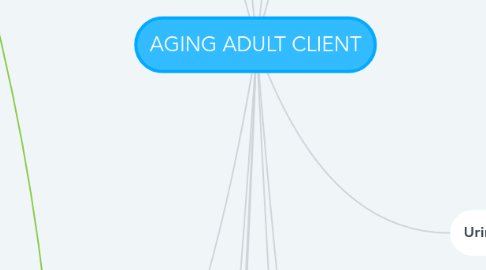
1. Respiratory
1.1. Age-Related Changes
1.1.1. calcification of costal cartilage and trachea
1.1.2. rib cage more rigid
1.1.3. increased residual capacity and reduced vital capacity
1.1.4. high risk for respiratory infections
1.1.4.1. inability to remove secretions
1.2. Pathologies
1.2.1. Pneumonia
1.2.2. Asthma
1.2.2.1. high risk for bronchiectasis, cardiac problems
1.2.2.2. assess for causative factors
1.2.2.2.1. EDUCATION
1.2.3. Chronic Bronchitis
1.2.3.1. persistent, productive cough
1.2.3.2. wheezing
1.2.3.3. current respiratory infections
1.2.3.4. shortness of breath
1.2.3.5. Treatment
1.2.3.5.1. Prevent OBSTRUCTION of airway
2. Cardiovascular
2.1. Age-Related Changes
2.1.1. heart dimensions are unchanged
2.1.2. heart muscle loses efficiency and contractile strength
2.1.2.1. reduced cardiac output
2.1.2.1.1. reduced activity tolerance
2.1.3. valves become thick and rigid
2.1.4. blood vessels reduce elasticity
2.1.5. oxygen used less efiiciently
2.2. Pathologies
2.2.1. Hypertension
2.2.1.1. consistent blood pressure reading >140/90
2.2.1.1.1. dull headache
2.2.1.1.2. impaired memory
2.2.1.1.3. disorientation
2.2.1.1.4. confusion
2.2.2. Postural hypotension
2.2.2.1. decline in systolic blood pressure of 20mm Hg or more after rising and standing for 1 minute
2.2.2.1.1. safety major issue
2.2.3. Atherosclerosis
2.2.3.1. hardening and narrowing of arteries due to plaque build up in vessel walls
2.2.3.1.1. decline in blood flow
3. Gastrointestinal
3.1. Age-Related Changes
3.1.1. less acute taste sensations
3.1.1.1. atrophy of tongue
3.1.2. decreased esophageal motility
3.1.3. atrophy of the small and large intestines
3.1.4. increased risk of aspiration, indigestion, constipation
3.1.5. decreased saliva production
3.1.5.1. xerostomia
3.1.5.1.1. saliva substitutes
3.1.5.1.2. sipping water
3.1.5.1.3. sugarless candy/gum
3.2. Pathologies
3.2.1. Dental Problems
3.2.1.1. can restrict food intake
3.2.1.1.1. constipation
3.2.1.1.2. malnutrition
3.2.1.2. affects appearance and socialization
3.2.1.3. potential financial limitations
3.2.2. Chronic constipation
3.2.2.1. diet low in fiber
3.2.2.2. inactivity
3.2.2.3. decreased blood flow to Gi system
3.2.2.4. interventions to promote bowel elimination
3.2.2.4.1. increase fluids
3.2.2.4.2. increase fiber in diet
3.2.2.4.3. medications
3.2.3. Intestinal Obstruction
3.2.3.1. Causes
3.2.3.1.1. Impacted stool
3.2.3.1.2. hernias
3.2.3.1.3. adhesions from surgeries
3.2.3.2. large intestine
3.2.3.2.1. cancer
3.2.3.3. small intestine
3.2.3.3.1. adhesions or hernias
3.2.3.4. Clinical Manifestations
3.2.3.4.1. severe abdominal pain
3.2.3.4.2. nausea
3.2.3.4.3. vomiting
3.2.3.4.4. inability to pass stool
3.2.3.5. Treatment
3.2.3.5.1. surgery
3.2.3.5.2. medical procedure
3.2.3.5.3. NPO
4. Musculoskeletal
4.1. Age-Related Changes
4.1.1. thinning disks and shortened vertebrae
4.1.2. reduced muscle mass, strength and movement
4.1.3. decreased bone mineral and mass
4.1.4. diminished calcium absorption
4.1.5. increased risk of fractures
4.2. Pathologies
4.2.1. Fractures
4.2.1.1. Risks
4.2.1.1.1. poor posture
4.2.1.1.2. unstable
4.2.1.1.3. slow reaction time
4.2.1.1.4. malnutrition
4.2.1.2. common places
4.2.1.2.1. hips
4.2.1.2.2. wrists
4.2.1.3. complications
4.2.1.3.1. immobility
4.2.2. Osteoarthritis
4.2.2.1. progressive deterioration of joint cartilage with the formation of new bone at joint surface
4.2.2.1.1. crepitus joint
4.2.2.2. genetic causes/obesity
4.2.2.3. pain management
5. Endocrine
5.1. Age-Related Changes
5.1.1. thyroid gland activity decreases
5.1.2. ACTH secretion decreases
5.1.3. Pituitary gland decreases
5.1.4. Insulin release by beta cells is delayed and insufficient
5.1.4.1. Higher blood glucose in non diabetic patients
5.1.5. Ability to metabolize glucose is reduced
5.2. Pathologies
6. Immune
6.1. Age-Related Changes
6.1.1. Depressed immune system
6.1.1.1. T-Cell activity declines
6.1.1.2. Cell-mediated immunity declines
6.1.1.3. Risk for infection increases
6.1.1.4. Inflammatory defenses decline
6.2. Pathologies
6.2.1. Cancer
6.2.1.1. Rapid and uncontrollable growth of cell, invading other organs
7. Sensory
7.1. Normal Age-Related Changes
7.1.1. Crystalized itelligence
7.1.1.1. knowledge accumulated over a lifetime: arises from dominant hemisphere of brain
7.1.2. Fluid intelligence
7.1.2.1. involves new information from nondominant hemisphere
7.1.2.1.1. controls emotions
7.1.2.1.2. creative capacities
7.1.2.1.3. spatial perceptions
7.1.2.1.4. aesthentic appreciation
7.1.3. Presbycusis
7.1.3.1. progressive hearing loss that occurs
7.1.3.1.1. distortion of HIGH- pitched sounds
7.1.3.1.2. cerumen increases
7.1.3.1.3. alteration in equilibrium
7.1.4. Presbyopia
7.1.4.1. inability to focus on close objects clearly
7.1.4.1.1. narrowing of visual fields
7.1.4.1.2. pupil size reduction and less reactive to light
7.1.4.1.3. depth perception distortion
7.1.4.1.4. decline in visual acuity
7.1.5. Touch
7.1.5.1. decrease in tactile sensation
7.1.5.1.1. reduction in sense to pressure, discomfort, temperature chang
8. Physical
8.1. Normal Age-Related Changes
8.1.1. Hair loss, graying, wrinkles
8.1.2. Loss of tissue elasticity, elongated ears, baggy eyelids, double chin
8.1.3. Loss of subcutaneous fat
8.1.3.1. Have difficult time regulated temperature
8.1.4. Diminished stature related to reduced hydration, loss of cartilage and thinning vertebrae
8.1.4.1. risk for falls
8.1.4.1.1. risk for fractures/ injury
9. Urinary
9.1. Age-Related Changes
9.1.1. decline in renal blood flow and GFR
9.1.1.1. approximately 50% by age 90
9.1.2. reduced bladder capacity
9.1.2.1. urinary freuquency
9.1.2.2. urgency
9.1.2.3. nocturia
9.1.2.3.1. frequent urination at night
9.2. Pathologies
9.2.1. Incontinence
9.2.1.1. types
9.2.1.1.1. stress
9.2.1.1.2. functional
9.2.1.1.3. urgency
9.2.1.1.4. neurogenic
9.2.1.1.5. overflow
9.2.1.2. assess
9.2.1.2.1. medial history
9.2.1.2.2. medications
9.2.1.2.3. functional status
9.2.1.2.4. cognition
9.2.1.3. treatment
9.2.1.3.1. goal is to identify cause
9.2.2. Bladder Cancer
9.2.2.1. causes
9.2.2.1.1. excessive alcohol use
9.2.2.1.2. tobacco use
9.2.2.2. clinical manifestation
9.2.2.2.1. hematuria
9.2.2.2.2. urinate more often
9.2.2.2.3. having weak stream
9.2.2.2.4. lower back pain on one side
9.2.2.2.5. loss of appetite and weight loss
10. Nervous
10.1. Age-Related Changes
10.1.1. decline in weight and blood flow to brain
10.1.1.1. does NOT affect thinking and behavior
10.1.2. reduction in neurons, nerve fibers, cerebral blood flow
10.1.3. slower response to change in balance
10.1.4. hypothalamus less effective in temperature regulation
10.1.5. Changes in sleep patterns with frequent awakening
10.2. Pathologies
10.2.1. Parkison's Disease
10.2.1.1. affects ability of the CNS to control body movements
10.2.1.1.1. tremor, stiffness, manlike facies , dyskinesia
10.2.2. TIA
10.2.2.1. temporary or intermittent reduction in cerebral perfusion
10.2.2.1.1. increased risk for cerebral vascular accident
10.2.2.1.2. s/s
10.2.2.1.3. treatment
11. Integumentary
11.1. Age-Related Changes
11.1.1. skin less elastic, dry and fragile
11.1.2. decreased subcutaneous fat
11.1.3. increased benign and malignant skin neoplasms
11.1.4. reduced sweat gland activity
11.2. Pathologies
11.2.1. Pruritis
11.2.1.1. itching and discomfort
11.2.1.2. potential for skin breakdown and infection
11.2.1.3. assess the underlying cause
11.2.1.3.1. treat with topical steroids, antihistamines, comfort measures
11.2.2. Stasis Dermatitis
11.2.2.1. inflammatory condition
11.2.2.2. clinical manifestations
11.2.2.2.1. itching
11.2.2.2.2. scaling
11.2.2.2.3. hyper pigmentation
11.2.2.2.4. ulceration
11.2.2.3. treatment
11.2.2.3.1. facilitate healing
11.2.2.3.2. interventions to enhance venous return
11.2.2.4. R/T chronic venous insufficiency
